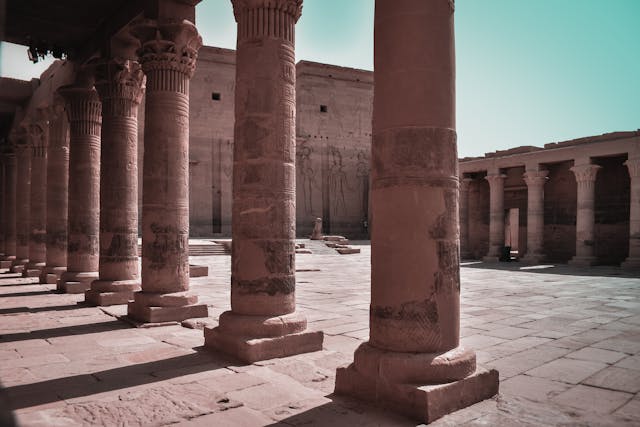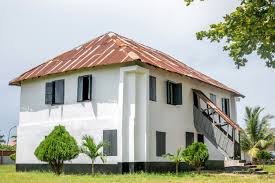




See Nigeria's First Storey Building built in 1800s.
History African@africanhistory
4 months ago
The First Storey Building in Nigeria, located in the historic town of Badagry, Lagos State, is a captivating historical monument that offers visitors a journey back to the colonial era, steeped in cultural and architectural significance. Visitors to this site will encounter a charming, whitewashed two-story structure, its wooden windows painted light blue, standing proudly on a sprawling compound overlooking the Marina waterfront, with the distant whispers of ocean waves and the rustling of palm trees creating an evocative backdrop that transports one to the mid-19th century, though the building’s exterior, while freshly painted in recent years, bears the weathered charm of its 180-year history, inviting reflection on its endurance through time, and the nearby well, dug in 1842, still used by locals, adds a living connection to the past, though visitors may note the irony of its continued utility amidst calls for better preservation, stirring thoughts on the intersection of history and daily life.
Inside, the building unfolds a treasure trove of historical relics, with rooms housing artifacts that tell the story of its missionary origins, including a missionary trust fund box inscribed with a plea to “donate generously to the maintenance of this building,” a silent witness to the ongoing struggle to preserve this landmark, and the portraits of key figures such as Reverend Henry Townsend, Reverend C.A. Gollmer, and Bishop Samuel Ajayi Crowther adorning the walls, alongside a wooden bench said to be the first used by the missionaries, offering a tangible link to the past, while the safe, designed in 1856 in West Bromwich, UK, used to store valuables, documents, and Bibles, stands as a testament to the era’s ingenuity, though the dim light filtering through open windows, the sole source of illumination, may prompt visitors to ponder the challenges of maintaining such a site without modern interventions, adding a layer of intrigue about the balance between authenticity and preservation.
The building’s historical significance is profound, recognized as the first documented European-style storey building in Nigeria, with its foundation laid in 1842 by Birch Freeman and Reverend Henry Townsend, and completed in 1845 by Reverend C.A. Gollmer, serving initially as a mission house for the Church Missionary Society, and its most famous occupant, Bishop Samuel Ajayi Crowther, lived here for seven years, translating the Bible from English to Yoruba, a monumental cultural achievement, with the English and Yoruba Bibles displayed in a glass case upstairs, aged over 170 years, offering visitors a chance to marvel at this linguistic bridge, though the counterclaims by some historians that multi-storey mud structures existed in northern Nigeria prior to 1845, or that earlier European buildings like “The Factory” in Ughoton, built by the Dutch in 1718, may predate it, add a layer of debate, encouraging visitors to question the narratives of “firsts” in history, making the visit a thought-provoking exploration of documented versus oral histories.
The site’s cultural resonance is enriched by its location in Badagry, a town steeped in history as a major slave port, with the building also serving as a lodging for returned slaves, a poignant reminder of its role in the abolitionist movement, and the nearby historical sites, such as the Badagry Heritage Museum and the Point of No Return, accessible within a short distance, provide a broader context of the trans-Atlantic slave trade, allowing visitors to weave together the threads of missionary work, slavery, and resistance, while the local children’s familiarity with the building, as evidenced by their casual references to its significance, adds a living dimension to its legacy, though the reported 1,800 visitors in a recent nine-month period, peaking during holidays, suggests a site that, while cherished, struggles for wider recognition, prompting reflection on how Nigeria values its historical treasures.
The natural setting enhances the experience, with the sprawling compound offering a serene escape from the bustle of modern life, and the ocean’s proximity, visible from the building, serving as a reminder of Badagry’s coastal heritage, with the potential for eco-tourism in the area, such as boat rides along the waterfront, adding an adventurous element to the visit, though the lack of formal tourist infrastructure, such as hotels or restaurants nearby, means visitors must come prepared, perhaps with supplies for a day trip, and the journey from Lagos, about an hour’s drive, offers a scenic route through coastal landscapes, with local guides or community members often stepping in to share oral histories, enriching the experience, though the absence of formal guides may require visitors to seek out these stories actively, turning the visit into a treasure hunt of knowledge.
Some narratives, including posts found on X, highlight the building’s role as a tourist attraction and historical landmark, with debates about its “first” status adding a layer of intellectual intrigue, and the philosophical question of why such a significant site, which once housed the first primary school in Nigeria and marked a turning point in education and religion, remains underfunded and under-visited may linger in the minds of reflective visitors, while recent reports of increasing visitor numbers, such as 13,609 in 2018, suggest a growing interest, though challenges like poor road access, as noted in past years, underscore the need for better infrastructure, making it a destination that challenges visitors to consider the broader story of Nigeria’s historical preservation efforts.
In summary, a visit to the First Storey Building in Nigeria offers a blend of historical immersion, cultural reflection, and natural beauty, set against the backdrop of a town that bridges Nigeria’s colonial and pre-colonial past, making it a must-visit for those interested in the missionary era, the slave trade, and the architectural evolution of a nation, with the added resonance of standing in a place that challenges visitors to ponder the narratives we inherit and the legacies we choose to preserve.
#FirstStoreyBuilding #Badagry #NigerianHistory #ColonialArchitecture #SamuelAjayiCrowther #MissionaryEra #CulturalHeritage #TravelNigeria #EcoTourism #SlaveTradeHistory #HistoricalLandmark #LagosState
Photo Credit: Legit NG
